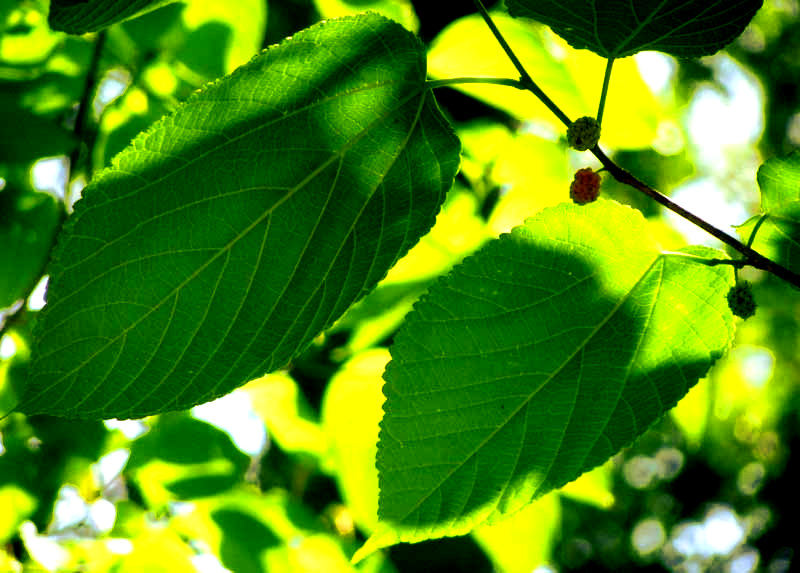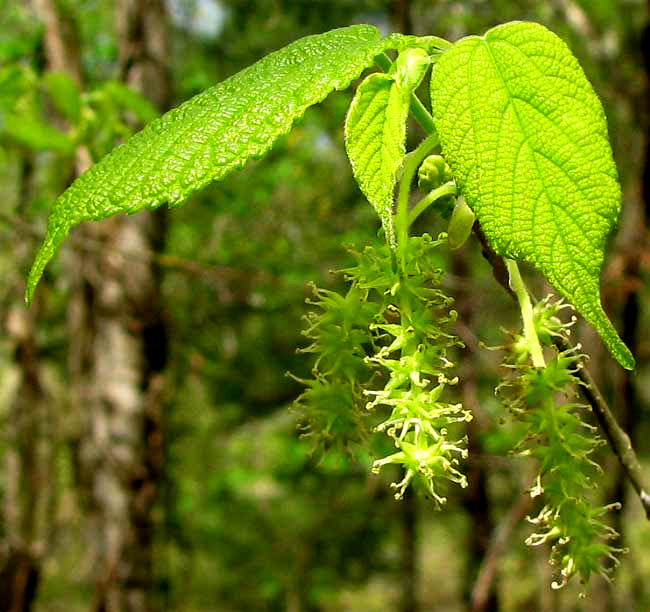Excerpts from Jim Conrad's
Naturalist Newsletter

from the the April 15, 2012 Newsletter, issued from the forest near Natchez, Mississippi; elevation ~400ft (120m), ~N31.47°, ~W91.29°:
RED MULBERRIES FRUITING
Also early, the Red Mulberries are bearing, as shown above. Red Mulberry fruits when ripe are dark purple or blackish. As the following entries show -- written at earlier dates -- this year the fruits are appearing earlier than usual.
from the the March 30, 2009 Newsletter, issued from the forest near Natchez, Mississippi; elevation ~400ft (120m), ~N31.47°, ~W91.29°:
RED MULBERRIES FLOWERING

Above you see leaves and long flower clusters, or aments, of our native, wild-growing Red Mulberry, MORUS RUBRA. You also see why Karen complains that this tree near her house never produces mulberries, despite each year at this time being full of flowers. All the flowers are male. They're male because the matchstick-like things on the dangling aments are classic male stamens consisting of slender white filaments atop of which baglike anthers are opening, releasing grainy pollen.
Red Mulberry trees don't always come in strictly male or female trees, however. Sometimes you can find both male and female flowers on the same tree, as with Red Maples.
It's too bad Karen's mulberries are male, for mulberry fruits produced around here are the best tasting I've ever encountered. I've often wondered if the area's previous occupants, the Natchez Indians, might not have developed an especially tasty mulberry race that later went wild, for it's know that the Natchez had a great regard for mulberries. In the Natchez Indians' annual cycle of 13 months the sixth month was "Mulberry Month," between "Peach Month" and "Great Corn Month." You can see all the Natchez's months at http://www.native-languages.org/natchez-months.htm.
from the May 11, 2003 Newsletter, issued from near Natchez, Mississippi:
RED MULBERRY
Biking the rough dirt track through the woods at the back of the plantation and watching the ground closely to avoid thorns and spoke-bending sticks I spotted penny-sized black smudges on the trail. A quick glance upward fulfilled my most optimistic hopes: Here stood a magnificent Red Mulberry tree, MORUS RUBRA, with limbs heavy with immature green fruits, half-mature red fruits, and perfectly ripe, purplish-black, glossy, succulent, ready-to-eat mulberries.
We have lots of mulberry trees at Laurel Hill but the birds, especially Cedar Waxwings, usually devour all fruits the moment they begin ripening. Apparently this tree's fruits were safe only because of its isolation deep in the woods, its anonymity among close-packed trees of other species.
This was the first time in my life that I'd been able to eat all the mulberries I wanted. I ate until my belly developed that certain you-better-watch-out cramp and my hands were comically stained dark purple, and probably my lips were, too. As I was pulling down the branches so I could reach the fruit it occurred to me that maybe this was why fibers of the inner bark of mulberry are so strong and stringy-- to keep limbs from snapping when large mammals graze the fruit, pulling down the limbs exactly as I was. I have read that Indians made clothing from fiber of the mulberry's inner bark. The Natchez Indians honored the mulberry by naming their sixth month, between the Month of Fishes and the Month of Great Corn, The Month of Mulberries.
There's no secret why mulberries are so delicious, for they belong to an aristocratic family famous for serving visitors fine food. Mulberries are in the Fig Family, which also is home to the wondrous tropical Breadfruit, Jackfruit, about 2,000 fig species, hops of beer-brewing fame, and cannabis hemp, the seeds of which make a fine, black substance like peanut butter.
from the December 16, 2001 Newsletter, issued from near Natchez, Mississippi:
YELLOW MULBERRY WOOD
I'm expanding one of the gardens, a process involving digging trenches where chicken wire will be sunk into the ground so that later regular fence wire can be placed above. This may slow down the armadillos as they dig their way into the garden.
One trench passes a mulberry tree and in cutting through some of the tree's roots I have been struck by how pretty its roots are. Their smooth bark is a pretty reddish purple, and the wood itself, at least when freshly cut, is a rich golden hue wonderful to look at.
M. Le Page Du Pratz, whom I introduced in the August 19 Newsletter, reported how the Natchez Indians used mulberry wood as a source for yellow dye. He mentioned how different dyeing techniques resulted in cloth with varying hues of yellow and gold. I can just imagine how handsome the Natchez's garments must have been, how their golden robes must have shone as they stood in the light of their sacred sun, on the loess bluff overlooking the Mississippi.
Really I think the mulberries of this area must be something special, possibly as a result of centuries of careful culturing by the Indians. The Natchez also wove fine garments from mulberry bark, something easy to believe if you try to break a twig from a mulberry without cleanly cutting it. Very strong fibers hold the snapped twig in place and if you keep tugging at it, it's so stringy that it tears a long gash down the limb.
The fruits, however, are the most delightful thing about them. I'll tell you about them when their time comes...